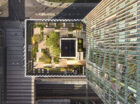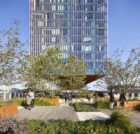
Can a single building change Londoners’ perceptions of what it means to live in a high-rise? That’s precisely what Harry Handelsman — the developer credited with transforming once-overlooked neighborhoods into epicenters of cool, with such projects as St. Pancras Renaissance Hotel and Chiltern Firehouse — has set out to do with Manhattan Loft Gardens in London.
Designed by SOM, the 42-story tower includes a hotel called The Stratford, named for the East End neighborhood where it rises. The site may seem an unlikely one for a high-end residential and hotel development. But Handelsman saw the potential ever since Stratford was selected as the site for the 2012 Summer Olympics. Since then, the district has been in the throes of a full-scale transformation that includes the creation of a £1.1 billion cultural center. By 2023, it will be home to new campuses for University College London and the London College of Fashion, along with cultural venues for the BBC, Sadler’s Wells Theatre, and the V&A Museum. All of this promises to bring new energy to east London — and Manhattan Loft Gardens is at the center of the action.
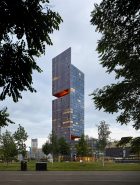
“My aim was to redefine the high-rise,” says Handelsman, an apt ambition for a city with ambivalent views on the building type. A 2013 survey found that 60 percent of Londoners said they would be happy to work in a tall building, but only 27 percent would like to live in one. To close the gap, Handelsman and SOM framed the project in social terms: “How can we create a vertical community?” they asked.
It’s clear at a glance that this tower is far from typical. Two diagonal slices are carved out of the building, with residential levels cantilevered above. The deep cutaways are inset with landscaped outdoor spaces, or “sky gardens,” which punctuate the 143-meter-tall structure.
Shared by the tower’s residents, the sky gardens serve a similar social function as London’s traditional residential squares and streetscapes, yet are translated vertically. “In most residential high-rise buildings, people seldom interact with their neighbors,” says Kent Jackson, the design partner who led the project. “We decided to change that completely.” The cantilevered design turns the garden levels into column-free vantage points. These are common spaces with uncommon views.
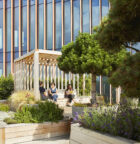
From loft to high-rise
Manhattan Loft Gardens is more than an apartment block —along with the boutique hotel it also includes two restaurants, a mix of uses that turns the building into a social engine. The effect is most pronounced in the lobby, a generous space where residents, hotel guests, and visitors intermingle.

Site-specific artworks enhance the experience of these spaces. The lobby features a suspended Paul Cocksedge installation that evokes a sheaf of paper caught in the wind. In the building’s open courtyard, an “optic sphere” sculpture by Petroc Sesti stands seven meters tall, reflecting light and the architecture that surrounds it.
Adding to the building’s dynamism is a mix of unit types and configurations, from studios to three-bedroom and penthouse apartments. These units vary not only in size, but also in volume: single-level apartments are interspersed with 1.5-story and duplex units which evoke the spatial qualities of industrial lofts.
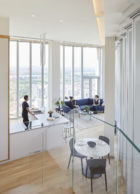
The design team was inspired by the variety of living spaces found in some of the city’s most vibrant neighborhoods. “We considered the reasons that Londoners were more interested in living in historic buildings, in Georgian and Victorian architecture,” Kent Jackson says. “Why couldn’t new buildings be as interesting, spatially and architecturally, and give you that same type of character?”

With its integrated architecture, engineering, and interior design, Manhattan Loft Gardens is a classic product of SOM’s interdisciplinary practice. “As we’re coming up with a concept, we’re working alongside the engineers to understand how we could create this type of space,” says Jackson. Just as essential was the team’s relationship with the visionary developer who sought to achieve something new. “I’d like to think we’re always being challenged as designers,” says Jackson, “but with this project in particular, the rapport with our client enriched the process.”
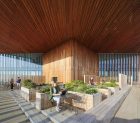
Engineering a solution
Achieving the tower’s double-cantilevered design was “a literal balancing act,” Jackson says. At the level of each sky garden, to open up expansive views, half of the perimeter columns are removed. “The building essentially has the same challenges standing up as a tree with two gigantic notches chopped out of it,” says Dmitri Jajich, the structural engineering director for the project.
The team first proposed a system of trusses, all in heavy steel, to transfer the load from the perimeter to the building core. This would have been the strongest and lightest structural solution, but complex and time-consuming to build. In London, the most important financial consideration is not the cost of materials, but the time it takes to get a project built. “Our real triumph was not the engineering solution per se,” Jajich says, “but rather developing something that could be built without undue complexity and allowed the schedule to keep moving.”
Ultimately the team found a hybrid solution that balances strength, efficiency, and constructability. A structural steel truss rings the perimeter of the level above each garden level, while a system of post-tensioned concrete connects the truss back to the concrete building core. By using concrete for both the core and transfer system, it could be built by the same construction crew, using the same material — saving time and allowing the project to be completed on budget. “We found a way to do something extraordinary, but to do it with conventional means as much as possible,” Jajich says.
The post-tensioning strands used to reinforce the concrete transfer system are at the size and scale that might be used on urban infrastructure — much larger than anything typically used in residential buildings. “We’re not bridge designers, but we often have to design buildings that work more like bridges to get them built,” says Jajich. “When this challenge came up, we weren’t shy about tackling it.”

Another feat was optimizing the space around the robust structural framework on the two transfer floors. Usually, a building’s mechanical systems would be housed within these levels. Instead, the design team turned them into some of the building’s most distinctive living spaces. “The steel members are exposed, and the concrete floors and walls were intentionally exposed to better explain the structure of the building to its occupants,” Jackson says. “It was an important way to bring out the character of the building and allow the residents to live within the structure.”
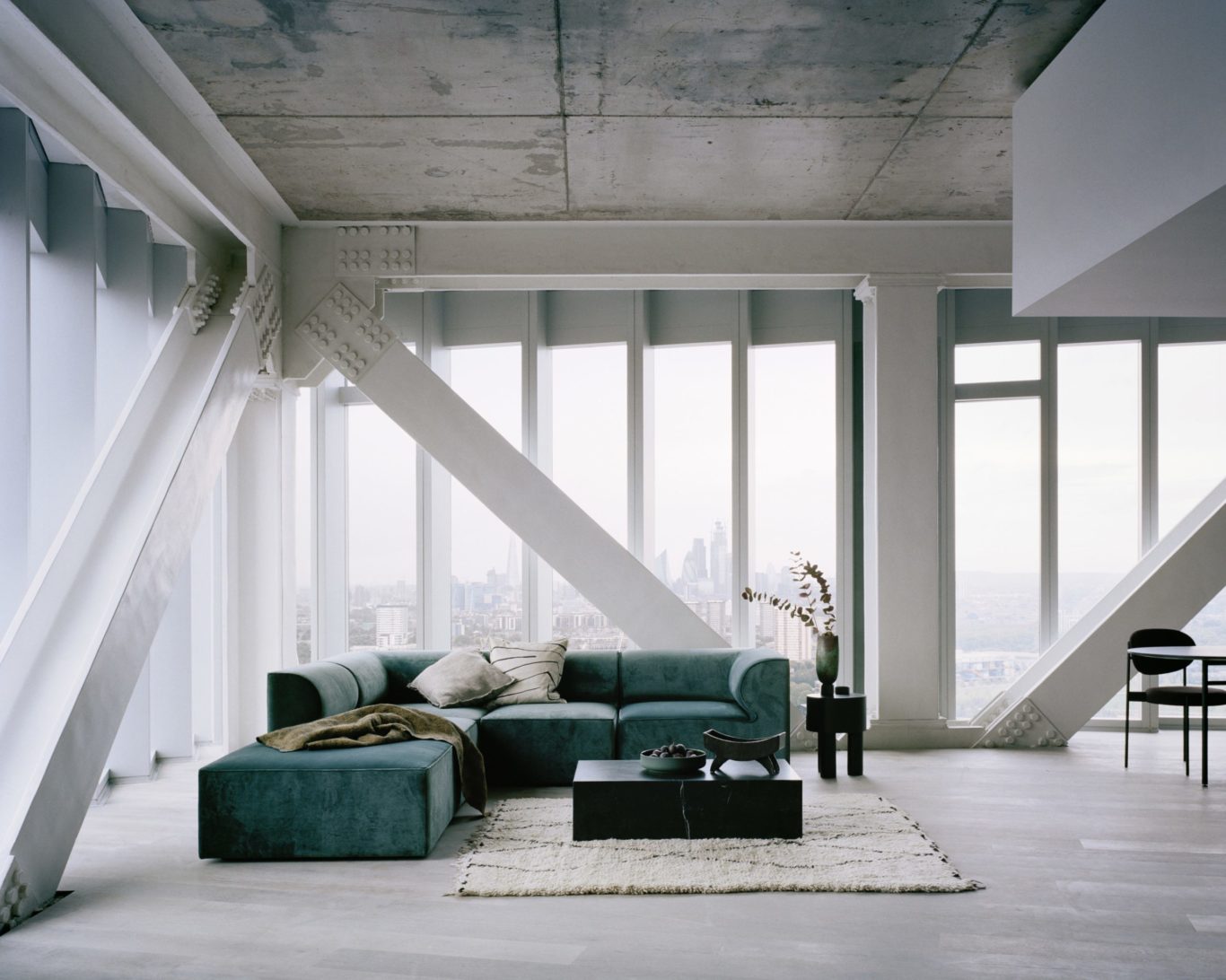
Each design decision also serves another purpose: creating a more sustainable building. Limiting the amount of construction material not only reduces costs but minimizes environmental impact. The distinctive facade design, with its mix of opaque and transparent materials, minimizes solar heat gain and brings in natural light. Even the sky gardens are part of a holistic sustainability strategy — with native plantings, feeders, and nesting boxes to attract birds, bees, and butterflies, these green spaces contribute to the district’s biodiversity.
A benchmark for vertical living
Nearly ten years since Handelsman first envisioned a high-rise in Stratford, London is seeing a new wave of vertical development. A recent survey found that of the 541 tall buildings underway in 2018, 90 percent are residential. As high-rise living spreads across the city — not just in central London, but increasingly in its outer districts — Manhattan Loft Gardens may serve as an influential example for how to create a stronger sense of community within a building. “It was important to establish a new benchmark for vertical living,” Jackson says. “We hope that people will learn from this project, and even expand on our ideas.”
